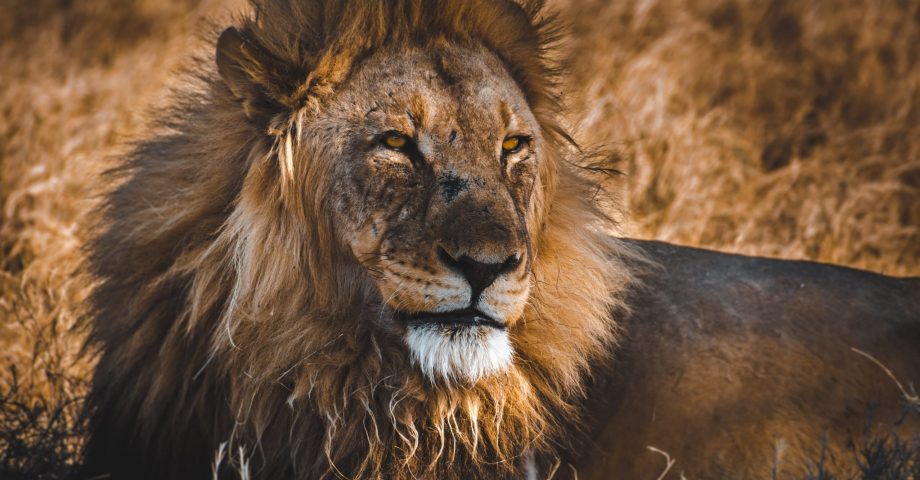Lions are one of the most majestic and most fearsome creatures on the planet! However, they are also often pretty misunderstood.
How much do you really know about this apex predator? It’s safe to say you probably shouldn’t get up too close to one – but there’s every reason why you’d want to learn more about them. Here are 36 fun facts about lions which are sure to fascinate you!
1. Lions are seriously hefty!
Lions are some of the heaviest animals on the planet. Generally, females will weigh around 290lbs or 130kg when fully grown, while males can grow to 400lbs or 180kg on average.
The heaviest lion ever weighed tipped the scales at 826lbs or 375kg! However, despite lions generally being pretty huge in size, you’ll find that tigers are even bigger en masse! Lions are, therefore, regarded as the second largest cats on the planet.
2. Lions live for more than a decade
The average lifespan of a lion can vary, but they will generally live in the wild for around 12 years. This can differ in captivity, and it may differ from breed to breed.
In fact, you can probably tell where a lion is from just based on its coat. Dark-furred lions generally come from regions which are hotter or are more arid. However, you can also find those lions which have white fur!
3. Lions are prideful animals – litreally
Unlike other cats – domesticated included – lions group together in prides. This makes them somewhat similar to canines, who group together in packs!
Prides can vary in size, but generally, you’ll see lions group together in up to 30 at a time. What decides the size? A few things – but they will group together wherever food and water is readily available.
As with domesticated cats and dogs, a lion will mark its territory with urine. This means that it will often urinate to create its own borders. That means to stay away!

4. Lions don’t actually live in jungles
Ever heard of the term ‘king of the jungle’? It’s misleading. Lions don’t live in jungle environments. They live in deserts, on grasslands and on green plains and fields. Who knows where that name first came from?
Rudyard Kipling’s ‘The Jungle Book’ is at least accurate in this respect, as the lion is one of few wild animals not to receive a mention in the story or its adaptations. Instead, the fearsome Shere Khan represents the big cats.
5. Female lions work the hardest
Female lions do most of the hard work. They go out and hunt and forage, while males keep guard and protect the pride.
Females, too, will bond for life. This means that any female cubs that grow up together are likely to still be friends later in life. It’s rare that mother and daughter lions will ever split up, either.
6. Lions are famously lazy!
Lions actually sleep or rest for most of the day. They’re similar to domestic cats in this regard! They actually spend up to 20 hours a day being inactive. Not a bad life to lead!
7. Lions’ eyes are pretty unique
While most cats have slit pupils, lions actually have round pupils instead. It’s thought that this is because lions need to hunt for larger prey than domesticated cats, and those who may generally hunt around for smaller bites. This can also help them hunt better at night, making lions some of the best nocturnal hunters in the feline world.
Lions’ eyes will change colour while they grow. Cubs are generally born with blue eyes. However, these will change around three months into their lives, into the yellowy brown or amber that we know and love.
8. There are lions pretty much everywhere
Lions are some of the best-travelled animals on the planet. You’ll find most of them in the wilds of Africa these days, however, they were once native to India and Europe. You’d even find them out in the US and Canada, for a time!
In fact, there are still a few lions that live out in India. These beasts can be found prowling around the Gir Forest. There are no more than 300 of them in total.
They are well-travelled thanks to their amazing adaptability. You’ll find that a lion can easily live on arid plains and in think grass. However, again, you won’t see them in any jungles or forests any time soon. Here, it’s tigers and jaguars you need to worry about!
9. Lions aren’t the quietest of beasts!
A lion’s roar is famously loud. You’ll know if a lion is nearby easily enough! However, you can hear a roar from up to five miles, or eight km, in the distance. Better start running!

10. A lion’s stamina is seriously impressive
Lions are also very fast but aren’t great at running for long periods of time. A lion can normally reach a top speed of around 50mph, or 80-81 kph. You can’t outrun them – but those that have a chance just need to count on the cats losing their breath mid-pace!
11. Lions really gorge themselves!
A lion is perfectly capable of eating around 15% of their weight in food if they are hungry enough.
It’s thought that a lion can – and will – eat up to 18lbs of meat each day, though this can vary. They can probably swallow more if they want to!
12. Lions make all kinds of sounds
Lions don’t just roar. In fact, they make plenty of noises that domesticated cats do, too! They are known to hiss when angry and even meow when they want attention.

13. The lion is a very popular symbol
Plenty of countries refer to the lion as their national symbol. England, famously, trades on the pride of a lion. However, Belgium, Luxembourg and Ethiopia all use the big cats as their main symbols.
14. Lions are versatile breeders
Lions can breed successfully with other types of big cat. For example, you can breed ligers and tigons, depending on which species is the male and which is the female.
You’ll actually find that lions don’t really have mating seasons. However, females are pretty clever about this and will mate when new males arrive to help populate a pride.
15. And they take it pretty seriously
When lions mate, they do so for three-day periods. They have breaks of around 30 minutes in between, however!

16. Lions are under threat
Sadly, while you will still plenty of lions out in the wild, many will face their habitats threatened. In fact, lions are part of the IUCN Red List. This list helps to document all animals who are considered under threat from extinction.
17. Lions are spring-footed!
A lion can not only run pretty fast, it can jump far, too. This certainly helps when it comes to catching fleet-footed prey and when stamina is on the wane! An average lion can, apparently, leap up to 36 feet. That’s a lot of ground to cover.
18. Lion manes are seriously impressive
No other big cats have the fabulous hairstyles male lions are famous for. That’s right – a lion’s mane is completely unique to its species. In fact, the thicker the mane, the more likely a lion is going to find a mate.
You can actually estimate the rough age of a lion by looking at its mane. Older male lions will have darker manes than their younger counterparts.

19. There are tons of lion breeds out in the wild
There are perhaps more types of lion in the wild than you imagine. People will normally be able to name Asian and African lions. However, there are around eight types in total. These can include Asiatic lions and Masai lions, as well as Ethiopian and Congo varieties.
20. Most lions have brothers and sisters
Lion litters vary in size, but you will normally find a female lion gives birth to up to four cubs in a single litter. It’s not uncommon for just one lion to be born.
21. Lions don’t use all of their paws
While lions have heels like many mammals, they never actually make use of them while running! This, supposedly, helps them to move quicker. As mentioned, they need all the speed they can get!
Lion paws, too, are notable for their dew claws. These are generally used much in the same way that people use thumbs! They are fantastic at helping lions keep prey under control once they have caught them.

22. Lions like a lot of space
Lion territories are famous for being absolutely massive. For example, you could find a lion territory that extends up to 100 square miles in size. As mentioned, lions can live almost anywhere, which means you are looking at a huge expanse of land for a pride to prowl across.
23. Lions have odd head movements
If a lion wants to look in different directions, it will normally need to move its head. Their eyes may be large, but their pupils cannot move from side to side as easily as other animals’ can.
24. Lion poaching is a serious problem
It’s estimated that around 600 lions alone are killed by trophy hunters each year. Despite widespread outcry, this is still an industry that leads to the export of lion bodies to the US and all over the world.

25. Lion claws are truly massive!
Ever seen the length of a lion’s claw? They are thought to be around the length of a human finger!
Lion claws are not fully retractable. They do, however, shrink back when they are at rest.
26. A lion learns to roar as a cub
Lions can actually roar from a very young age, despite what certain Disney movies may tell you! Lions are able to start roaring from around the age of two years old.
27. Lions scavenge more than prey
Lions are known scavengers, more so than active predators. In fact, most of a lion’s diet is made up for food they sources while scavenging around!

28. Buffalo kill scores of lions each year
Believe it or not, buffalo are known for causing a huge array of lion deaths. They are said to be the deadliest of all prey a lion may be known to hunt for.
29. There’s a lion gender divide!
Some male lions won’t actively live with females in their prides. Asiatic lions, for example, will only live alongside the other gender in their prides if they are looking to mate, or if they have killed a large number of prey.
30. Male lion puberty is rather strange
Male lions can start breeding from the age of two, however, they won’t be able to act on this until they are around five years old and can therefore command a pride. Female lions, meanwhile, will normally have given birth by the age of four.
A male lion can stay virile right up to 16 years of age.

31. We discovered lions thousands of years ago
Early human species are thought to have started coming across lions as long ago as 32,000 years. This is, at least according to ancient cave paintings, the case.
32. Lions have seriously big mouths
A lion can open its full jaw up to a foot in size, which is likely enough to fit a human head into – hence some of the death-defying circus acts lion tamers used to endure.
33. It’s hard to damage a lion’s stomach
Lions have loose skin around their abdomens. This is so that if they are kicked or scratched, very little damage is caused. Lions will generally chase after prey with hooves which are known to give a fair back-kick!

34. There are fewer lions in Africa than you might think
Africa was once home to more than 200,000 lions. In the wild these days, you will probably only find around 10% of this living on the continent.
Asiatic lions, however, appear to be reproducing at a healthy rate. It’s thought that their population growth has increased by around 27% in the last decade. It will remain to be seen whether this upturn continues, though increased conservation is thought to be helping a great deal.
35. Lions go for massive kills
Lions are able to kill huge prey. As mentioned, they often come into contact with buffalo, which can be very dangerous indeed! However, a lion is likely capable of hunting down and killing prey of up to 1000 lbs in weight.
Lions tend to pull down their prey by snatching at their ankles, meaning that they will often reach out for a scratch.
36. The lion is a ‘brave’ beast
The lion is famously seen as a symbol of bravery. For example, King Richard ‘The Lionheart’ took his nickname from these majestic beasts. Turning things on their heads, the Cowardly Lion is a key character in the popular story The Wizard of Oz.
FAQs about Lions
What are lions scared of?
Not much! Lions get the label of being ‘brave’ - however, it’s more to do with the fact that they’re not really under natural threat in the wild.
Are lions stronger than tigers?
Push come to shove, studies show that tigers would actually prove stronger than lions.
Is the lion really the king of the jungle?
Many believe that the elephant is the true monarch - as lions generally respect the biggest pachyderms!
How fast can a lion run?
For short distances, lions can run at an incredible 50 mph (80 kph)!
Do you know any interesting or fun facts about Lions? Share them in the comments below!
Do you love cats? Check out these fun facts about cats










Comments are closed.